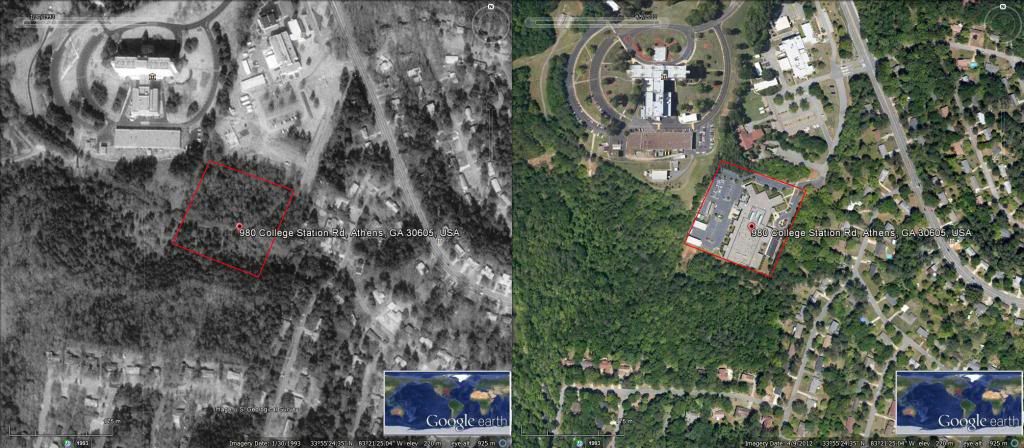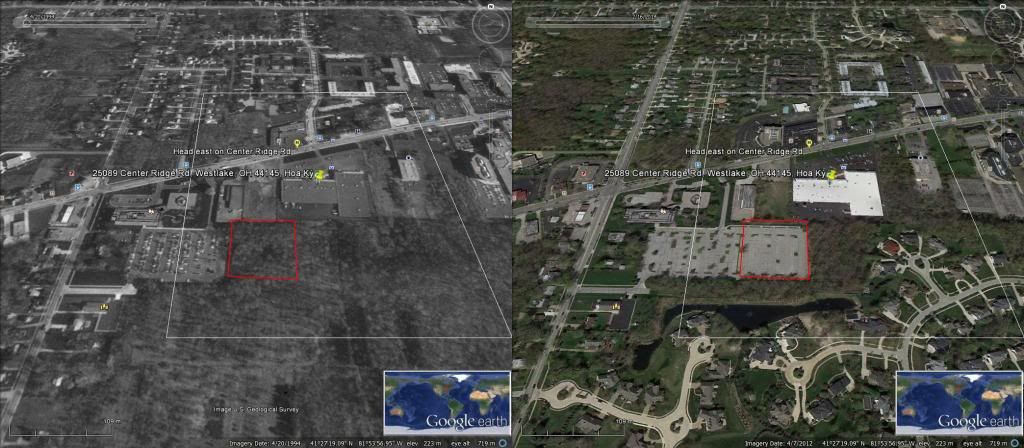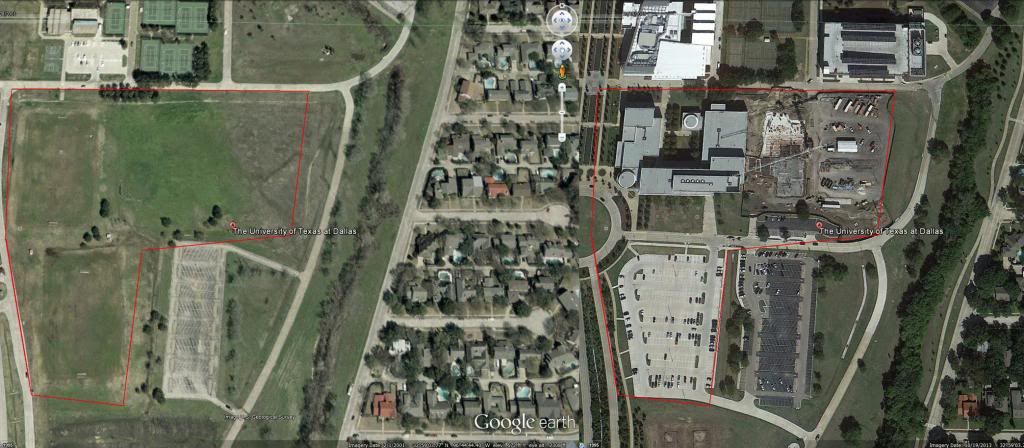This is a part of my manuscript :

This is Google Earth image of United States Environmental Protection Agency Region 4 Science and Ecosystem Support Division , 980 College Station Road Athens, Georgia 30605-2720 (SESD ).
Left picture use Google data , date 1993 . Right picture , date 2012
Total facility area : 66,201 gross square feet ( GSF ) . To build United States Environmental Protection Agency Region 4 Science and Ecosystem Support Division need 66,201 gross square feet of forest .I use Google and with dense density of forest here , I estimate 1 acre tree here have 300 trees per acre . 1 acre = 43560 square feet . So 66201 gross square feet / 43560 = 1.5 so in the past here we had : 300* 1.5 = 450 trees .
"A single mature tree can absorb carbon dioxide at a rate of 48 lbs per year- McAliney, Mike. Arguments for Land Conservation: Documentation and Information Sources for Land Resources Protection, Trust for Public Land, Sacramento, CA, December, 1993
On average, one tree produces nearly 260 pounds of oxygen each year. Two mature trees can provide enough oxygen for a family of four. Environment Canada, Canada's national environmental agency
So in 1 year 450 trees of 66,201 gross square feet can absorb CO2 : 48 * 450 = 21600 lbs CO2 .
In 1 year 450 trees here create O2 : 260 * 450 = 117000 lbs O2 .
According to United States Environmental Protection Agency ‘s website ,
http://www.epa.gov/region4/sesd/sesd.htmlhttp://www.epa.gov/region4/sesd/about.htmlhttp://www.epa.gov/oaintrnt/facilities/athens-sesd.htmAnd 2011 report of US EPA :
http://www.epa.gov/region4/ej/Jacksonville_EJ_FINAL.pdfUnited States Environmental Protection Agency doesn’t have a plan to re - plant 450 trees for overcome the environmental damage here in Climate Change . If we think about conservation of absorbing CO2 , and creating O2 , Earth today lost : 21600 lbs CO2 of absorbing and 117000 lbs of creating in Climate Change age , when we really need to increase absorbing CO2 of plants . Or Earth today absorb CO2 smaller than Earth of the past 21600 lbs CO2 and creating O2 smaller Earth of the past 117000 lbs CO2
because of United States Environmental Protection Agency Region 4 Science and Ecosystem Support Division , 980 College Station Road Athens, Georgia 30605-2720 (SESD ).

This is a parking area at United States Environmental Protection Agency Region 5 , Cleveland Office , 25089 Center Ridge Road Westlake , OH 44145 – 4170 , USA .
Date of left picture is 1994 , right is 2014
I use Google Earth measure the areaand have a result : 108900 gross square feet . To increase the size of parking area , US destroy a 108900 square feet of forest . Forest here has a dense density so I choose 1 acre have 300 trees so 108900 square feet have : 108900 / 43560 = 2.5 so total trees here in 1994 is 750 trees .
So in 1 year 750 trees 108900 square feetcan absorb CO2 : 48 * 750 = 36000 lbs CO2 .
In 1 year 450 trees here create O2 : 260 * 750 = 195000 lbs O2 .
According to United States Environmental Protection Agency’s website :
http://www2.epa.gov/aboutepa/epa-region-5US EPA Region 5 , Cleveland Office don’t have a plan to re – create 750 trees after they destroy environment of this area to build the parking area . So about conservation of CO2 and O2 , the 2014 Earth absorb CO2 less than the Earth 1994 36000 lbs CO2 and the 2014 Earth create O2 less than the Earth 1994 195000 lbs O2 because of parking area at United States Environmental Protection Agency Region 5 , Cleveland Office , 25089 Center Ridge Road Westlake , OH 44145 – 4170 , USA . Because I only can choose what Google Earth have and the historical image of Google Earth only can move to the past 1994 , if I can move farer , I can prove the whole truth United States Environmental Protection Agency Region 5 , Cleveland Office , 25089 Center Ridge Road Westlake , OH 44145 – 4170 , USA
Green building – LEED green standard are followed by Argentina Green Building Council , Green Building Council of Australia , Green Building Council Brasil , Peru Green Building Council , Canada Green Building Council Dutch Green Building Council , Emirates Green Building Council , France Green Building Council , German Sustainable Building Council , Indian Green Building Council Italy Green Building Council , Japan Green Building Consortium , Korea Green Building Council , Mexico Green Building Council New Zealand Green Building Council , Green Building Council of South Africa ,Sweden Green Building Council , Taiwan Green Building Council , Romania Green Building Council , United Kingdom Green Building , Council U.S. Green Building Council Vietnam Green Building Council and World Green Building Council , all are correct if we focus on conservation all environmental index ? Because all Climate summit focus on how can we decrease high CO2 level of atmosphere so on this article , we only analyzing absorbing CO2 value , creating O2 value of the environment of the past and the present of some buildings . I will analyze this green standard is good or not .
According to Wikipedia and US Green Building Council :
http://en.wikipedia.org/wiki/Leadership_in_Energy_and_Environmental_Designhttp://www.usgbc.org/articles/qa-univers...ion-green-buildI will analyze University of Texas at Dallas , first academic building in Texas to receive LEED Platinum status. This is the area of University of Texas at Dallas :

I use Google Earth , date of image on the left : 2001 , date on the right : 2013 .
The wild grass area = 14.6 acres .
Mature grasslands sequester 2400 - 3600 lbsCO2 per acre each year – Technical Assessment of the Carbon Sequestration Potential of Managed Turfgrass in the United State ,Dr . RanajitSahu , 2008 at the request of the Outdoor Power Equipment Institute .
It is estimated that a 50 by 50 foot lawn (2,500 square feet), releases enough oxygen for a family of four, while absorbing carbon dioxide, hydrogen fluoride and perosyacetyle nitrate This means that one square foot of grass will produce approximately half a kilogram of oxygen a day .
I choose this type of grassland absorb lowest CO2 value : 2400 lbs CO2 per year . Because wild grass doesn’t cover 100 % percent of this area and I estimate 50 % percent of this area in 2001 cover by wild grass so
In 1 year 14.6 acres with 50% cover by wild grass absorb : 14.6 * 2400 * 50% = 17520 lbs CO2 per year .
In 1 year 14.6 acres with 50% cover by wild grass create : 43560 * 0.5 * 14.6 * 365 * 50% = 58152712 kg O2 .
1 kg = 2.2 lbs so 58152712 kg O2 * 2.2 = 127935966.4 lbs O2 .
University of Texas at Dallas doesn’t have a plan to re –create palnts can absorb 17520 lbs CO2 and create 58152712 lbs O2 . Because of University of Texas at Dallas - LEED Platinum certificate , Earth today lost 17520 lbs of absorbing CO2 , 58152712 lbs O2 of creating O2 .
We build a lot of roads . And a road go through a wild grass area , bush trees , a forests , …. Roads decrease of absorbing CO2 , water , creating O2 value of wild grass area , forest , …… of all countries . And all countries don’t have conservative rule to re – create plants in replace for all plants area turn into roads area .
Have you ever see airport ? A really large area without plants . If we destroy all plants for airport’s area to build airport . We should find a empty place , and plant any kind plants , to make it replace absorbing CO2 , water , creating O2 value = value of absorbing CO2 , water , creating O2 of the airport’s environment ( plants) in the past .
Even your city , town design with 70 % for plants and 30 % for building , house , it's not correct because conservation of CO2 , O2 , water need more 30 % of plants and this area of plants must absorb CO2 , water , create O2 value at least equal with absorb CO2 , water , create O2 value of 30 % of the past .
Before I write this article , none of any architecture know about conservation of CO2 , O2 even they design our city , town , ……. world thousand years ago . So the design problems of conservation of CO2 , O appear some thousand years ago .
According to Wiki :
http://en.wikipedia.org/wiki/Green_buildingReducing environmental impact : Green building practices aim to reduce the environmental impact of building. The first rule is that the greenest building is the building that doesn't get built. Since construction almost always degrades a building site, not building at all is preferable to green building, in terms of reducing environmental impact. The second rule is that every building should be as small as possible. The third rule is not to contribute to sprawl, even if the most energy-efficient, environmentally sound methods are used in design and construction. Urban infill sites are preferable to suburban "greenfield" sites .
The green building standard and our green standard have a serious mistake about conservation of CO2 , O2 because before people build the building , the area for a building usually have plants , trees , bush trees , wild grass , ….
After we build the building , plants , trees , bush trees , wild grass , …. ( which absorb CO2 , water , create O2 ) replace by building ( which doesn’t absorb CO2 , water , create O2 ) . After we build the building , compare between the past and the present , the area of the building lost a value of absorbing CO2 , water and creating O2 . According to conservation of CO2 , O2 , water of the past , for the conservation of the Earth at the present , we must find another area doesn’t have plants , than plant trees or any kind of plants to restore the absorbing CO2 and creating O2 ( in replace for plants of the past of building’s area ) value for the present .
Green building standard are followed by 19 countries around this world don’t force the owners of buildings
re – create the environment of the past to re – archive absorbing CO2 value and creating O2 value after they build the building .
All other protecting environmental definition , law systems don’t talk about conservation of absorbing CO2 , creating O2 :
http://en.wikipedia.org/wiki/Sustainable_architecturehttp://en.wikipedia.org/wiki/Environmental_designhttp://green.wikia.com/wiki/LEED_Certificationhttp://en.wikipedia.org/wiki/Leadership_in_Energy_and_Environmental_DesignInternational Environmental Law :
https://www.ncjrs.gov/App/Publications/abstract.aspx?ID=132294United States Environmental Protection :
http://www2.epa.gov/laws-regulationsAustralia: Nabers / Green Star / BASIX (in NSW only)
Brazil: AQUA / LEED Brasil
Canada: LEED Canada / Green Globes / Built Green Canada
China: GBAS
Finland: PromisE
France: HQE
Germany: DGNB / CEPHEUS
Hong Kong: BEAM Plus
India: Indian Green Building Council (IGBC)/ GBCIndia (Green Building Construction India)/ GRIHA
Indonesia: Green Building Council Indonesia (GBCI) / Greenship
Italy: Protocollo Itaca / Green Building Council Italia
Japan: CASBEE
Jordan: Jordan Green Building Council
Korea, Republic of: Green Building Certification Criteria / Korea Green Building Council
Malaysia: GBI Malaysia
Mexico: LEED Mexico
Netherlands: BREEAM Netherlands
New Zealand: Green Star NZ
Pakistan: Pakistan Green Building Council
Philippines: BERDE / Philippine Green Building Council
Portugal: Lider A / SBToolPT®
Qatar: Qatar Sustainability Assessment System (QSAS)
Republic of China (Taiwan): Green Building Label
Singapore: Green Mark
South Africa: Green Star SA
Spain: VERDE
Switzerland: Minergie
United States: LEED / Living Building Challenge / Green Globes / Build it Green / NAHB NGBS / International Green Construction Code (IGCC) / ENERGY STAR
United Kingdom: BREEAM
United Arab Emirates: Estidama
Turkey : CEDBİK
Thailand : TREES
Vietnam: LOTUS Rating Tools
Czech Republic: SBToolCZ
The protecting environmental laws system , green standard help to decrease absorbing CO2 value and decrease creating O2 value of the Earth today .
Our Earth have Global Serious Errors of Design .






